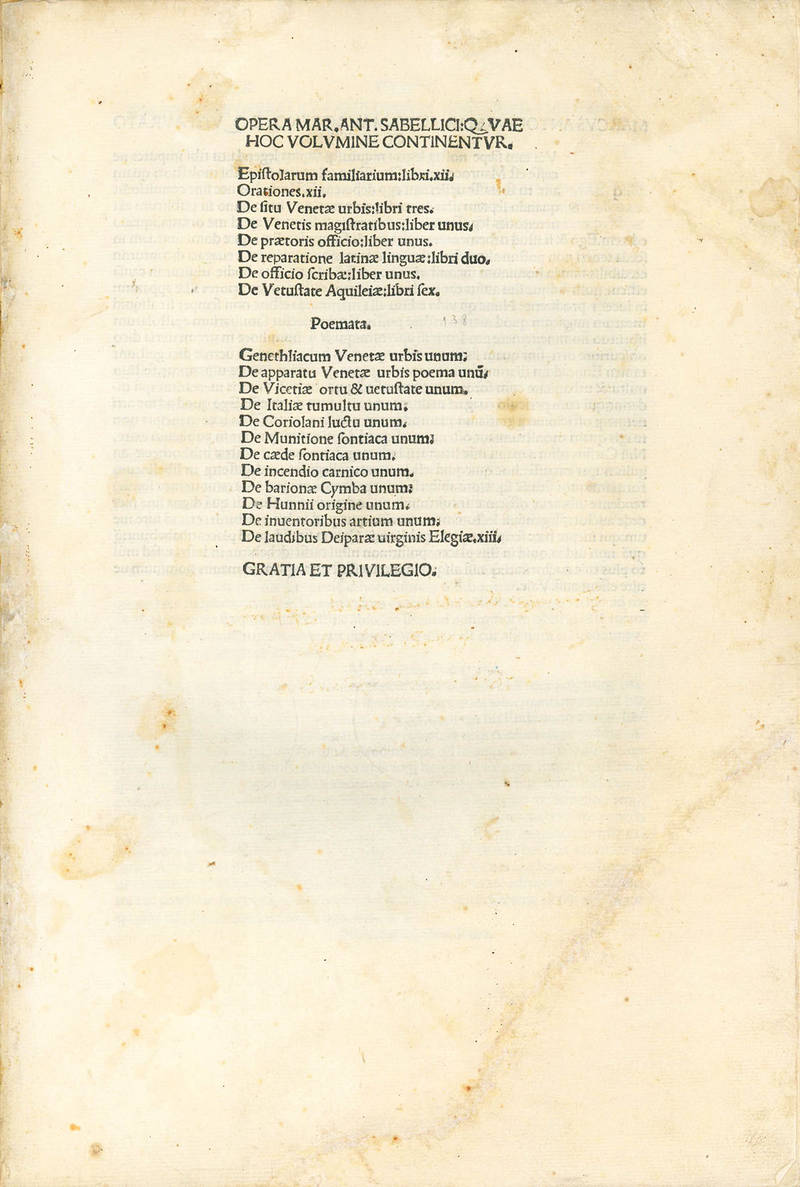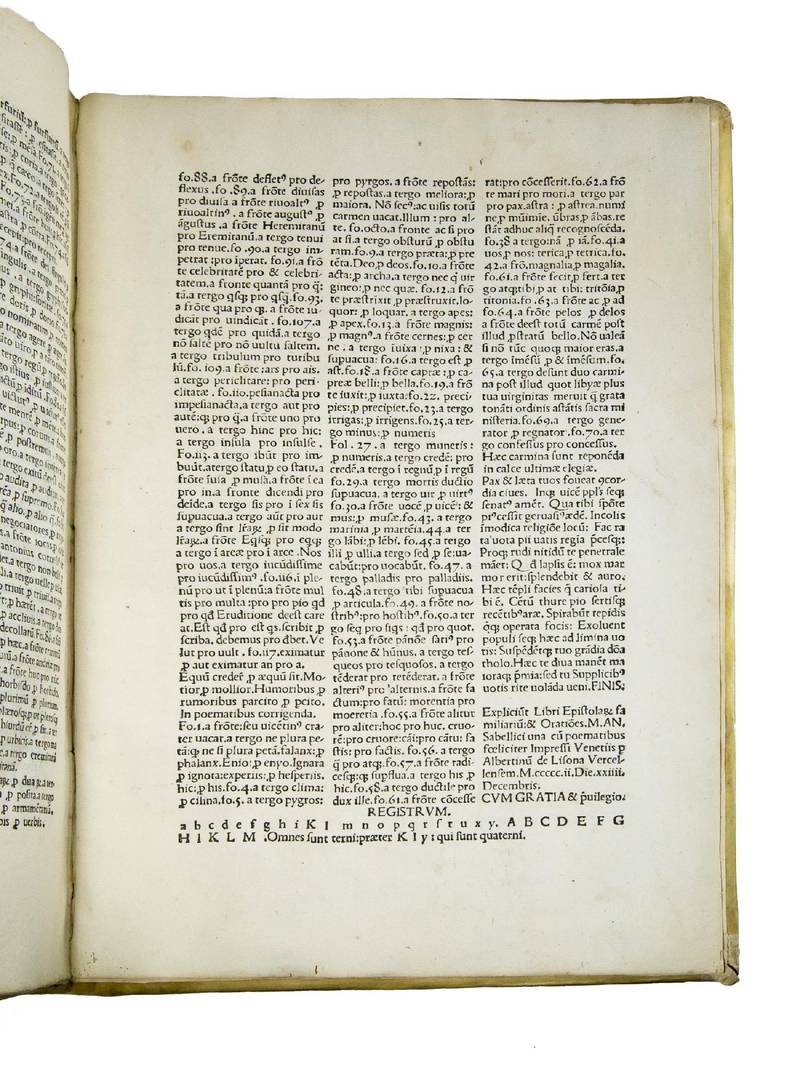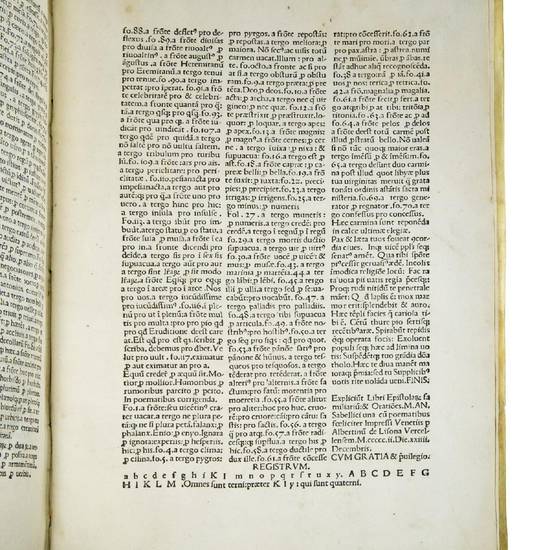Folio. Two parts in one volume. 136 [i.e. 138] leaves; [72] leaves. Collation: a-i6, K8, l8, m-x6, y8; A-M6. Old vellum over boards, some contemporary marginal annotations. Restoration to lower outer corner of the title page not affecting the text.
Edit 16, CNCE 24232; Goff, S-4; S.D. Bowd, Venice's Most Loyal City: Civic Identity in Renaisssance Brescia, (Cambridge, MA, 2010), p. 318; M. L. King, Venetian Humanism in an Age of Patrician Dominance, (Princeton, N.J., 1986), pp. 426-427; B. Richardson, Printing, Writers and Readers in Renaissance Italy, (New York, 1999), p. 187.
FIRST COLLECTED EDITION of Sabellico's works and first edition of his twelve books of letters (occupying leaves a1v-l1v), which are a most important source for his biography. The Epistolae, dedicated to Marcantonio Morosini, are followed by Orationes, De situ Venetae urbis (a topographical description of the city of Venice as it was during the author's life), De Venetiis magistratibus, De praetoris officio, De reparatione Latinae linguae (considered the first historical and connected narrative of the Renaissance movement in Italy), De officio scribae (on the office of a government secretary), and De vetustate Aquileiae. The whole second part consists of his neo-Latin poetry, of which the poem De rerum et artium inventoribus, in which he enumerates the inventions of mankind and their inventors, is the most interesting (cf. R. Chavasse, ‘De inventoribus rerum': Marcantonio Sabellico and Polydore Virgil, in: “Polidoro Virgilio e la cultura umanistica europea”, R. Bacchielli, ed., Urbino, 2003, pp. 207-224).
W.A. Copinger (Supplementum, London, 1895-1902, no. 5196) attributes the first part to a printer from Brescia around 1490. In fact there is some visible difference in the typographical material and woodcut initials between the two parts of the volume (cf. M. Sabellico, De latinae linguae reparatione, G. Bottari, ed., Messina, 1999, p. 72).
Among Sabellico's correspondents were members of his family, especially his son Mario and his brother Catalucio da Coccio, and a wide range of personalities: fellow humanists, church dignitaries, political leaders and noblemen, e.g. Giovanni Stefano Emiliano, Pomponio Leto, Giovanni Antonio Flaminio, Ermolao Barbaro, Antonio, Benedetto and Tommaso Trevisan, Giorgio Merula, Angelo Sabino, Jacopo Filippo Foresti, Sebastiano Badoer, Leonardo Loredan, Palladio Negri, Giovanni Battista Cantalicio, Paolo Santonino, Pietro Barozzi, Angelo Poliziano, Antonio Bonfini, Gasparino Barzizza, Pietro and Paolo Marsi, Andrea Mocenigo, Carlo Barbavero, Agostino and Marco Barbarigo, Francesco Piccolomini, Girolamo Donà, Domenico Grimani, Lodovico Sforza, Ercole d'Este, Giovanni Bentivoglio, Lodovico Odasi, Antonio Bonfini, Guidobaldo da Montefeltro, Bernardo Bembo, Girolamo Squarzafico, Fabio and Giovanni Pontano, Coriolano Cippico, Antonio Corner, Antonio Moretto.
One letter is addressed to a woman: the learned Cassandra Fedele. The collection also contains some letters addressed to him (e.g. Pomponio Leto). That his letters became models of an elegant style is shown nine years later after its first publication by a selection of letters entitled Breviores epistolae, ‘for teaching the rudiments of the Latin language to adolescents', which were published at Leipzig in 1511 (two editions in that year, reprinted in 1513 and 1520). They could be classified by topics such as family, sons' education, editing and publishing, dedication and patronage, classical texts, Venetian life and ceremony.
The letter at p. 52 is addressed to the poet and playwright Marco Armonio (1477-c. 1552), who in 1500 had written and staged in Venice a neo-Latin comedy entitled Stephanium, which was greeted with great enthusiasm. In the letter, Sabellico, who had the chance to read the comedy before it was published around 1503 and had attended first-hand its first staging, praises the work for the ‘argumentum, dignitas personarum, sententiarum gravitas, verba cum vetusta, tum figura et lepore Plautinis simillima”, using a terminology that is clearly taken from Aristotle's Poetics, whose first edition had appeared in Venice only a few years earlier (1498) in the Latin translation by Lorenzo Valla. This may well be one of the very first mentions of Aristotle's principles on poetics and their application to a contemporary literary text (cf. W. Ludwig, Einleitung, in: G. Armonio, “Ioannis Harmonii Marsi Comoedia Stephanium”, Munich, 1971, pp. 12-17).
“Marcantonio Sebellico's Epistolae familiares were collected by his amanuensis, Giovanni Carsio, and published in Venice in 1502. The indispensable Carsio was like a ‘family member' in the extended households of Venice and Vicovaro [...] He was not an ideal humanist editor, but he did include much that reveals Sabellico's network, household and family bonds. The letters are generally undated, the years are never given, though occasionally the day and the month are added [...] The letters, in Alison Holcroft's words [Going Public: Marcantonio Sabellico and the 1502 Collection of his Letters, unpublished paper] ‘if a little lacking in hard data on education, are wonderful as soap opera!' [...] His Letters reveal lived emotion as well as ideal or exemplary emotion. Further Sabellico felt an emotional bond with his creative work and spoke of his own books as his children or servants, thereby conveying something of his sense of household bonds. He played on the dual meaning of familiares as servants or with epistolae as informal or domestic newsletters” (R. Chavasse, Humanist Educational and Emotional Expectations of Teenagers in Late Fifteenth-Century Italy, in: “Emotions in the Household, 1200-1900”, S. Broomhall, ed., New York, 2008, pp. 70-71).
“Le [lettere le] aveva messe assieme e stampate nel 1502 il Sabellico medesimo, benchè nella graziosa dedica a Marco Antonio Morosin abbia voluto far credere che la raccolta, la divisione in libri e la stampa si dovevano all'antico suo amanuense, allora maestro di scuola Giovanni Carsio, e che egli solamente non l'avesse impedita: ciò che gli avremmo forse potuto credere, se si fosse ricordato di togliere dall'epistolario qualche lettera che lo smentisce recisamente” (G. Mercati, Ultimi contributi alla storia degli umanisti, Città del Vaticano, 1939, II, pp. 1-2)
“In late Quattrocento Venice the foremost manipulator of the power of print publication among writers was Marcantonio Sabellico. He, it has been suggested, probably deserves the title usually reserved for Erasmus - that of being the first writer to make a career from the new medium. When he came to have his twelve books of letters printed, he professed lack of enthusiasm about releasing what he termed these base slaves from his house. Yet the academies success which he enjoyed in Venice owned much to the ways in which he took advantage from the press” (B. Richardson, op. cit., p. 83).
“Some good descriptions of the work at the School of San Marco can be found in the letters of Sabellico, who taught there for twenty years - from 1486 to 1506, longer than any other humanist. However, a remark on one of these letters suggests that not only the heavy burden of work, but also another reason might have limited the attractiveness of the School of San Marco: the low, or at least uncertain, position of a professional humanist in Venetian social structure. Sabellico mentioned with pride that not only the sons of citizens but also from members of the Venetian nobility attended his language classes; he added that although they were frequently held at his house he never heard from his pupils anything about Venetian politics” (F. Gilbert, Humanism in Venice, in: “Florence and Venice: Comparisons and Relations. I: Quattrocento”, Firenze, 1979, p. 16).
Marcantonio da Coccio was born of poor parents in Vicovaro (northeast of Rome). He received his early schooling in his native town and then continued his studies in Rome under Pomponio Leto, Gasparino Barzizza, Domizio Calderini, and Porcelio Pandone. While in Rome he took part in the life of Leto's Roman Academy and adopted his humanistic ‘nom de plume': Sabellico. In 1473 he was called to Udine to teach rhetoric but also continued his studies in dialectics, mathematics, and Greek. In 1482 appeared his first work in print De vetustate Aquileiae patriae. He was dismissed from his employment in Udine, and spent over a year in Verona, where he completed twenty-two of the thirty-three books of his history of Venice. In 1487 he presented this work (printed in 1487) to the doge and senate, and soon afterwards he was appointed to the second public lectureship in the humanities at the school of San Marco (cf. F.Lepori, La scuola di Rialto dalla fondazione alla metà del Cinquecento, in: “Storia della cultura veneta. Dal primo Quattrocento al Concilio di Trento”, G. Arnaldi & M. Pastore Stocchi, eds., Vicenza, 1980/81, pp. 600-605).
On the death of Giorgio Valla (1500), who had the first lectureship, Sabellico took over his position. He also served as librarian to the collection of books which Cardinal Bessarion had given Venice, but which was as yet without a permanent home. Sabellico repaid the republic's largesse by writing and publishing further works in praise of Venice as well as a description of the city in three books and a dialogue on the Venetian magistrates (1489). In addition he continued his literary studies and produced commentaries on Pliny the Elder, Valerius Maximus, Livy, Horace, and other classical authors. Several of his orations and his philosophical, moral, and historical minor works attest to both his productiveness and his rise to considerable prominence in Venice. Toward the end of his life he published his historical magnum opus, a universal history from the Creation, under the title Enneades seu rhapsodiae historiarum (1498). A second part was printed in 1504 (cf. R. Chavasse, The ‘Studia Humanitatis' and the Making of a Humanist Career: Marcantonio Sabellico's Exploitation of Humanist Literary Genres, in: “Renaissance Studies”, 17/1, 2003, pp. 27-38; see also G. Rita, Da Vicovaro a Venezia: introduzione a Marcantonio Sabellico, Vicovaro, 2004, passim).
[9103]






